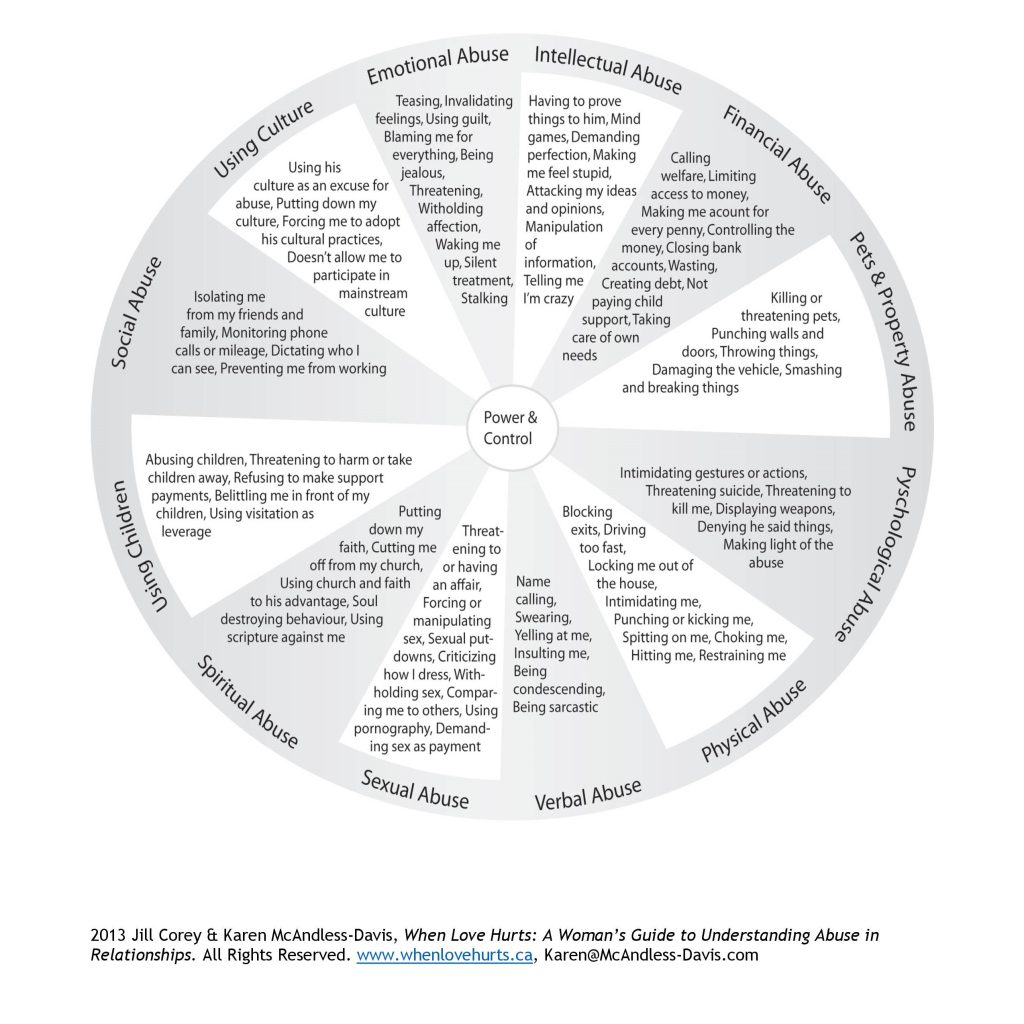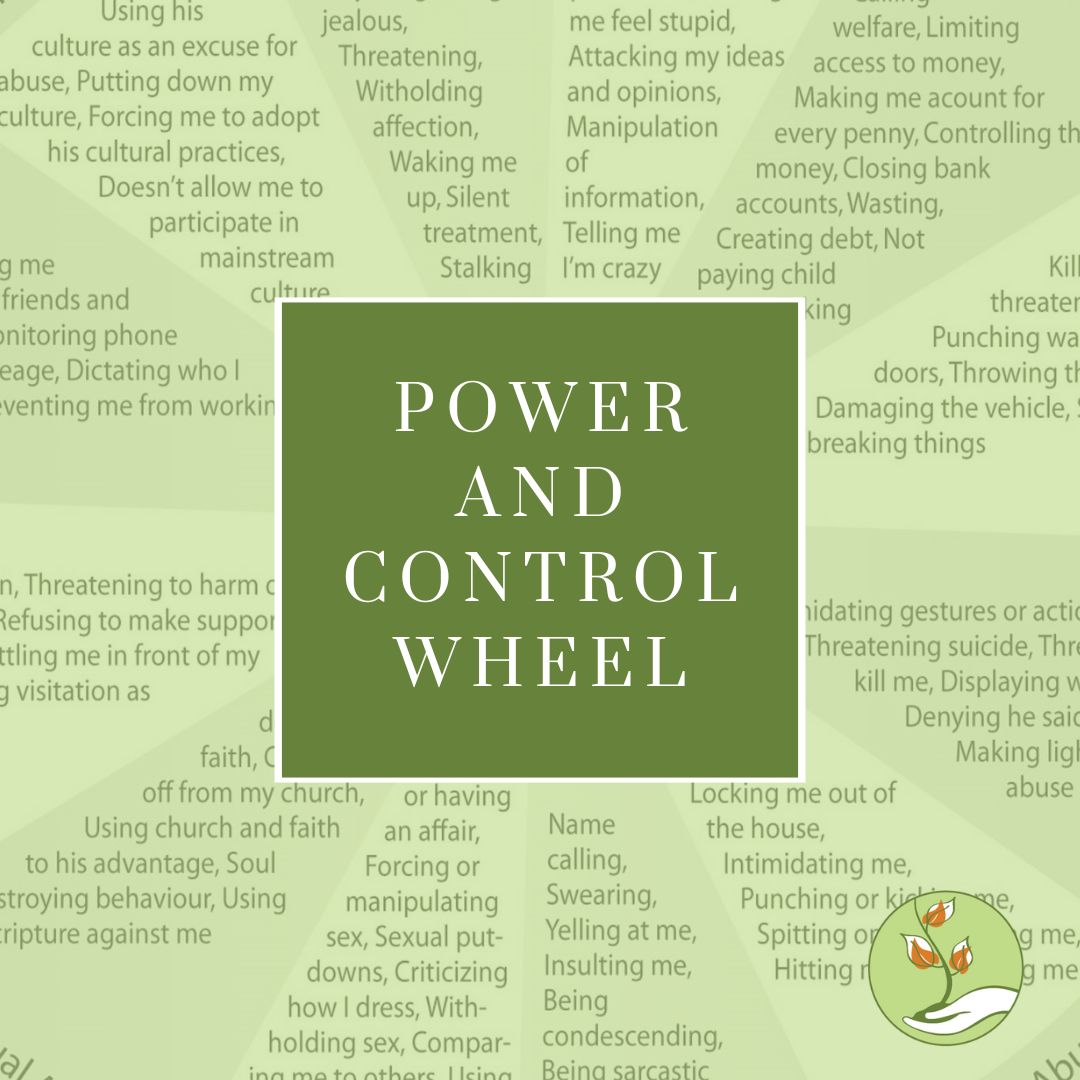Understanding the Power and Control Wheel
The Power and Control Wheel is a key tool for spotting abuse and understanding how abusers exert control. By recognizing these patterns, victims and professionals can better identify and address abuse. Here is a visual of the wheel with more in-depth descriptions of each section below:

ATTENTION: If you are currently experiencing domestic abuse and are torn between your commitment to God and your safety, WE CAN HELP. Please explore our website and contact us when ready. We are here for you. Back to the article.
Spiritual Abuse
Spiritual abuse is a deeply harmful tactic where an abuser exploits the victim’s religious or spiritual beliefs to manipulate and control them. This form of abuse can manifest in various ways, such as twisting religious teachings to justify abusive behavior, isolating the victim from their faith community, or using spiritual beliefs to instill guilt, shame, or fear.
For example, an abuser might claim that their authority is divinely ordained or that the victim’s suffering is a test of faith. By distorting spiritual beliefs, the abuser undermines the victim’s sense of self and spirituality, making it harder for them to seek help or even recognize the abuse.
In some cases, spiritual abuse can involve forbidding the victim from practicing their religion or forcing them to follow a different faith. This can be particularly devastating for victims who rely on their spiritual community for support and guidance. The isolation and confusion created by spiritual abuse can leave victims feeling trapped and disconnected from their own beliefs, making it one of the most insidious forms of control within the Power and Control Wheel.
Using Culture
Abusers might twist cultural norms and beliefs to justify their behavior. They use societal expectations to make it harder for victims to get help or leave the relationship. For example, an abuser might claim that their actions are consistent with traditional gender roles or cultural practices, making the victim feel obligated to stay in the relationship or comply with the abuser’s demands. This tactic is particularly effective in cultures where there is strong pressure to conform to specific roles or where leaving a relationship is stigmatized. By leveraging cultural norms, the abuser reinforces their control and isolates the victim from potential support systems.
GOD SAYS NO TO ABUSE.
If You Are Ready Break Free From The Cycle Of Abuse, Fill Out Our Confidential Form And One Of Our Compassionate Care Coordinators Will Reach Out About Our Program Or Call Us at (978) 266-0053 ext 1
Emotional Abuse
Emotional abuse aims to destroy the victim’s self-esteem. It involves constant criticism, embarrassment, and guilt-tripping. Over time, this makes victims feel worthless and more reliant on their abuser. The abuser may use tactics such as name-calling, belittling the victim’s achievements, or playing on their insecurities. By eroding the victim’s confidence and self-worth, the abuser creates a dependency that keeps the victim trapped in the relationship. Emotional abuse can be difficult to recognize because it doesn’t leave physical scars, but its impact on the victim’s mental health and well-being is profound. For a more in-depth article on an emotional abuse including an emotional abuse checklist, please click HERE.
Intellectual Abuse
Intellectual abuse undermines the victim’s thinking and decision-making. It includes belittling their opinions, limiting their access to education, or questioning their intelligence. This tactic isolates victims and strengthens the abuser’s control. By making the victim doubt their own judgment, the abuser creates a sense of confusion and helplessness. The abuser may also discourage or prevent the victim from pursuing educational or career opportunities, further limiting their independence. Intellectual abuse is a powerful tool for maintaining control because it attacks the victim’s ability to think critically and make informed decisions.
Financial Abuse
Financial abuse involves controlling the victim’s access to money. Abusers might prevent victims from working, control their income, or withhold money. This makes it difficult for victims to leave because they are financially dependent. The abuser may take complete control of the household finances, monitor the victim’s spending, or even steal money from them. By keeping the victim financially dependent, the abuser ensures that they have no resources to escape the relationship. Financial abuse is one of the most common forms of control in abusive relationships, and it can have long-lasting effects on the victim’s financial stability and independence.
Pets and Property Abuse
Abusers may harm pets or destroy property to control the victim. By threatening or mistreating pets and damaging belongings, they create fear and reinforce their power. This form of abuse is particularly effective because it targets things that the victim cares about deeply. The abuser may use threats against pets or property as a way to intimidate the victim or punish them for perceived disobedience. The fear of losing a beloved pet or having their home destroyed keeps the victim in a constant state of anxiety, making it harder for them to leave the relationship.
Psychological Abuse
Psychological abuse is designed to confuse and frighten victims. It includes tactics like gaslighting, threatening self-harm, or making the victim doubt their own reality. This ongoing fear keeps victims under control. Gaslighting, in particular, is a powerful form of psychological abuse where the abuser manipulates the victim’s perception of reality, making them question their memories, beliefs, and sanity. The abuser may also use threats of self-harm or suicide to manipulate the victim into staying in the relationship. Psychological abuse can be incredibly damaging, leading to long-term mental health issues such as anxiety, depression, and PTSD.
GOD SAYS NO TO ABUSE.
If You Are Ready Break Free From The Cycle Of Abuse, Fill Out Our Confidential Form And One Of Our Compassionate Care Coordinators Will Reach Out About Our Program Or Call Us at (978) 266-0053 ext 1
Physical Abuse
Physical abuse is the most visible form of control. It includes hitting, slapping, or other acts of violence. The abuser uses this abuse to enforce dominance and instill fear. Physical abuse can escalate over time, with the abuser using increasingly severe violence to maintain control. The threat of physical violence keeps the victim in a constant state of fear, making it difficult for them to seek help or leave the relationship. Physical abuse is often accompanied by other forms of abuse, such as emotional or psychological abuse, creating a cycle of control that is difficult to break.
Verbal Abuse
Verbal abuse involves using words to belittle and insult the victim. This may encompass name-calling, shouting, and condescending remarks. It attacks the victim’s self-worth and reinforces the abuser’s control. Verbal abuse can be just as damaging as physical abuse, as it erodes the victim’s self-esteem and sense of identity. The abuser may use verbal abuse to humiliate the victim in front of others or to undermine their confidence in private. Over time, the victim may internalize the abuser’s words, believing that they are worthless or deserving of the abuse.
Sexual Abuse
Sexual abuse involves forcing or pressuring someone into sexual activities against their will. The abuser uses it to assert dominance and violate the victim’s autonomy. Sexual abuse can take many forms, including rape, coerced sex, or unwanted sexual touching. The abuser may use threats, intimidation, or physical force to compel the victim to comply with their demands. Sexual abuse is a profound violation of the victim’s bodily autonomy and can have long-lasting effects on their mental and emotional health. The trauma of sexual abuse can also make it difficult for victims to seek help or leave the relationship.
Using Children
Abusers may manipulate victims through their children. This can involve threatening to take the kids away, using them as messengers, or undermining the victim’s parenting. This not only harms the victim but also affects the children. The abuser may use the children as pawns in the relationship, threatening to harm them or take them away if the victim tries to leave. This creates an additional layer of control, as the victim is forced to stay in the relationship to protect their children. The impact of this abuse on the children can be devastating, leading to long-term emotional and psychological issues.
Social Abuse
Social abuse isolates victims from their friends and family. Abusers control who the victim interacts with and limit their social activities, making them more dependent on the abuser. By cutting off the victim’s support network, the abuser ensures that they have no one to turn to for help. The abuser may also spread lies or rumors about the victim, further isolating them from their social circle. Social abuse is a powerful tool for maintaining control because it leaves the victim feeling alone and powerless.
Conclusion
The Power and Control Wheel helps to clearly identify different forms of abuse. For victims of domestic violence, recognizing these tactics is crucial for both understanding and addressing abuse. This knowledge empowers victims to seek help and take steps to break free from abusive relationships. By understanding the various sections of the power and control wheel, victims and professionals can work together to create safer, healthier environments for those affected by abuse.

